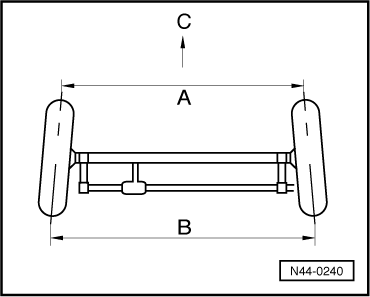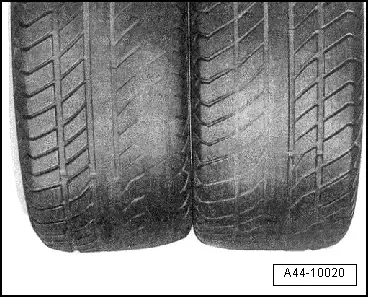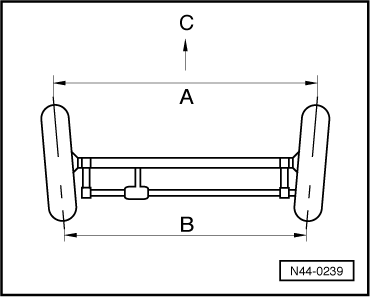| The distance between the wheels is smaller at the front edge -A- than at the rear edge-B- (-C- in the direction of travel). |
| To prevent lateral wear of tyres, the wheel adjustment should be checked to ensure that it is within the tolerance margin specified by the vehicle manufacturer. The most common causes of imbalance in wheels are external, e.g. hitting the kerb when parking. |
| By measuring wheel alignment it is possible to determine whether the wheel balance lies within the tolerance margin or whether the wheels require balancing. |
| Modifications to the running gear |
| Lowering the running gear or fitting light alloy wheel rims not recommended by Seat may result in wheel imbalance when driving. |
| As a result of the modified lever arm due to the reduced height and the position of the wheels when driving, uneven wear takes place, even if all the values lie within the tolerance margins when the wheel alignment is checked while the vehicle is at a standstill. |
| To avoid one-sided wear to the tyres it is necessary to ensure that the wheels are properly aligned on the one hand and, on the other, that the vehicle is used as intended. |
| Good vehicle and tyre maintenance will help to reduce wear. The following points should be remembered: |
| t
| The minimum specified tyre pressures should be maintained. |
| t
| It is not possible to prevent greater wear of the drive-wheel tyres as a function of driving style. To reduce this effect, interchange the tyres between the axles regularly. For example, by taking advantage of the change from summer tyres to winter tyres and vice-versa. This rotation ensures that all tyres were evenly and that a complete set of new tyres can be installed when required. This helps to prevent the fitting of tyres with different treads on the axles, which may have a negative effect on the handling of the vehicle. |
| t
| If the vehicle is not driven aggressively, the expected pattern of wear will be like the teeth of a saw → Chapter. The noise of the tyres increases, but will gradually decrease as tread wear becomes deeper. In the event of slight saw-tooth wear or where the saw-tooth is still forming, it is usually sufficient to interchange the tyres between axles. In the event of considerable saw-tooth wear, the wheels should be changed in such a way as to ensure the direction of travel is altered → Chapter. |
| t
| Some tyre treads give the optical impression of premature wear: if the winter tyre film is worn or there are cuts in the tread, only the compact blocks of the tread remain without the negative part, giving the impression that the tyre is worn. In this case, the remaining tread depth in each of the grooves should be measured. When the tread depth is greater than the minimum permissible tread depth, the tyre can continued to be used without limitations (in Germany the minimum tread depth is 1.6 mm), We recommend using winter tyres with a remaining tread depth of up to 4 mm in summer only, in Austria is even required). |
|
|

|





